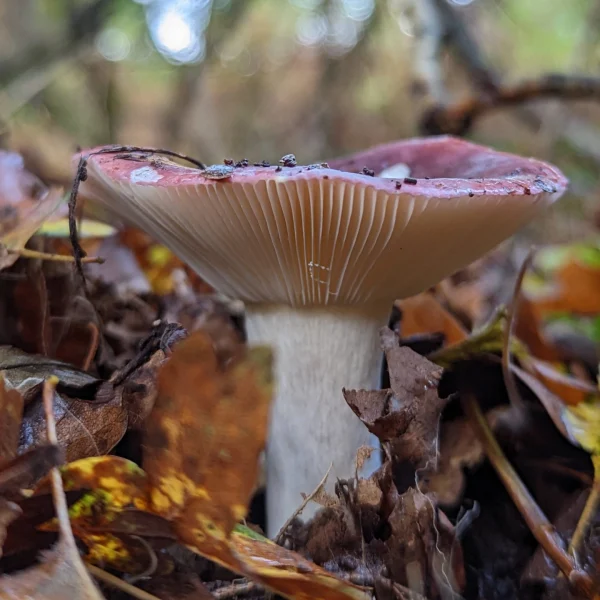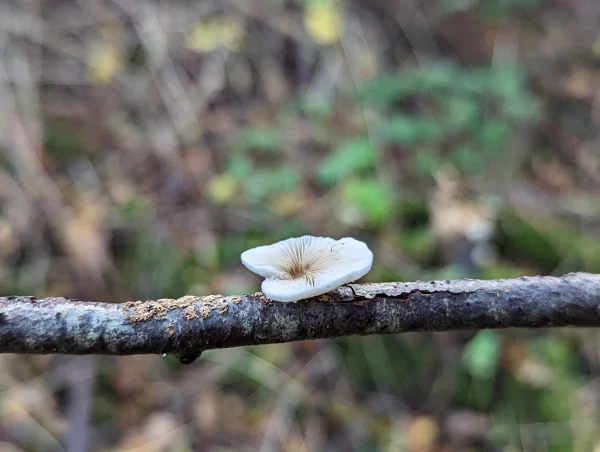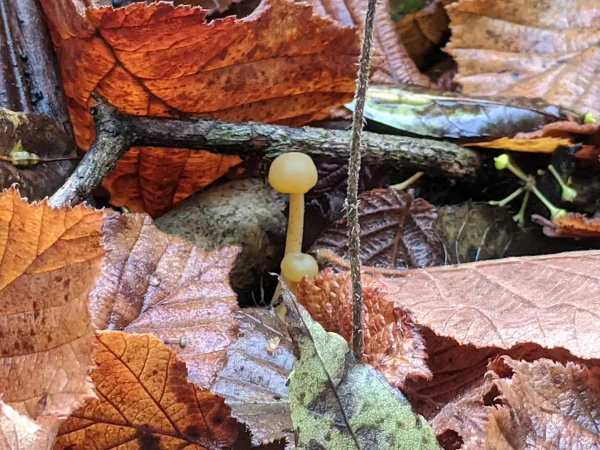Day 7
– 29 October 2022
Click on an image to see the fungus entry page
Today the weather was damp and the air cold, with drizzly rain and a partially cloudy sky.
CAR PARK
At the end of the main car park entrance path I saw some Coprinopsis atramentaria and some Coprinellus disseminatus.
Along the path from the car park I spotted some Armillaria which I also found in clusters in the grassy margins of the reception area.
ENTRANCE AREA
On the woodland trail towards Basecamp I saw more Armillaria, a juvenile Bolbitius titubans (Fig. 7.0) and some Russula species (Fig. 7.1).
I also saw the Tricholoma album from previous weeks and the remnants of the Cortinarius saturninus.
BASECAMP AREA
Near Basecamp I saw some slimy orange fungi (Figs. 7.2) and the Tricholomopsis rutilans and Laccaria laccata from previous visits.
At Basecamp, on one of the logs, I found a small crust fungus (Fig. 7.3).
Behind Basecamp on the path to the railway line, the Psathyrella piluliformis on the ivy covered stump was still there.
I saw Tremella aurantia and Stereum hirsutum (Fig. 7.4), as well as a bobbly slime mould, possibly a Trcihia species (Fig. 7.5).
THE DELL
In The Dell I found a troop of small white fungi (Fig. 7.6), a brightly-coloured Russula fungus (Fig. 7.7), some Spinellus fusiger and a slime mould — possibly Physarum album (Fig. 7.12).
I spotted a Crepidotus species (Fig. 7.10), more Tremella mesenterica (Fig. 7.9) and an oozing parasitised bolete (Fig. 7.10)
On the side of a log, I spotted some Trichia decipiens (Fig. 7.7), and on a twig I saw another group of small white fungi (Fig. 7.11).
The Typhula juncea had spread and enveloped the leaf litter at the edges of the Dell.
SANDY-GLADE AREA
On the path from The Dell to the Gnarly Oak I spotted a Phallus impudicus (Fig. 7.16).
ENCLOSED AREA
On the drainage channel path, I saw the Bulgaria inquinans again.
In the Enclosed Area, I saw more Typhula juncea, Clavulina coralloides and the Picipes badius and from previous weeks.
I spotted a singular Leotia lubrica (Fig. 7.17), a Pterula species (Fig. 7.18) and a Pluteus aurantiorugosus (Fig. 7.19).
Returning to the path, on the bench at the end of the drainage channel, I spotted Calocera cornea (Fig. 7.20).
OUTPOST AREA
Around The Outpost I saw a couple of Typhula fistulosa, some Russula ochroleuca and, further along the trail, the prolific Auricularia auricula on a log.
TRAIL END AREA
Checking up on the Phallus impudicus eggs from week four, I found one of them had matured whereas the other was just the same as before.
On the way, I stumbled upon a odd shaped form produced by Phlebia radiata.

















